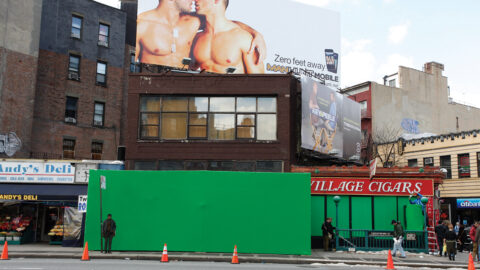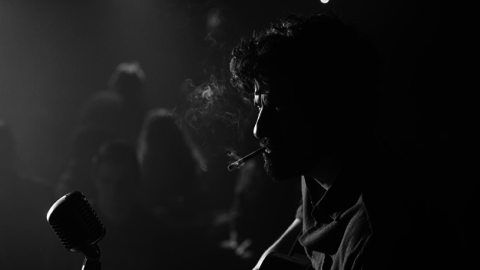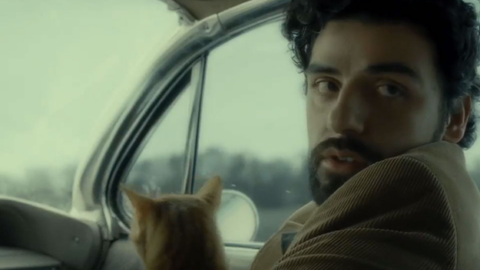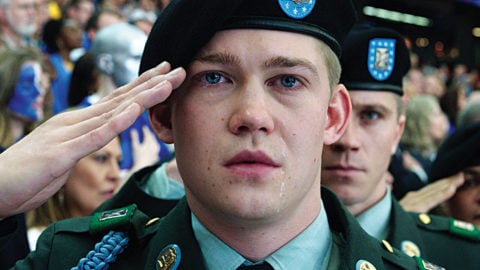Interview: Alexander Lemke
“Recognizing how routinely and fundamentally VFX is changing what cameras capture also means altering how we think about cinema,” Film Comment Digital Editor Violet Lucca observed in her November/December 2016 feature “The Cleaning Crew.” “The scope of participation by VFX artists raises profound questions of authorship. Do VFX artists in fact have more influence over the mise en scène and overall visual look of a film than the director or cinematographer, or are they just craftspeople working toward a shared goal? As David Bordwell rightly acknowledges in his recent book The Rhapsodes, filmmaking is not simply a Fordian system whereby each department on a production contributes a standardized component to create the finished product. It’s a matter of artisans who leave their unique marks on what we’re watching.”
In preparing the feature, Lucca spoke with one such digital artisan, Alexander Lemke, the co-founder and VFX supervisor of East Side Effects, in an interview providing a snapshot of contemporary VFX workflow practices and labor concerns.
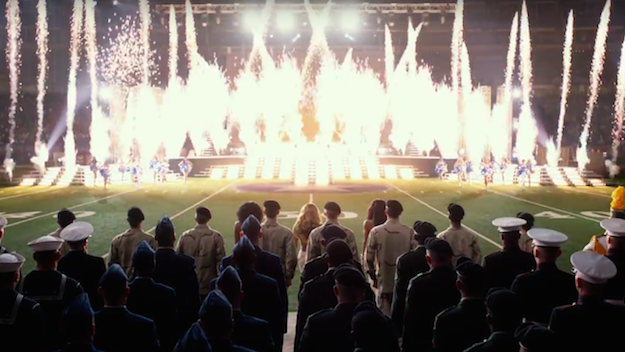
Billy Lynn’s Long Halftime Walk
There’s this book by Michael Pollan called The Omnivore’s Dilemma, where part of his argument is that because we have so many choices about what to eat, we end up making terrible choices. Do you feel that people don’t necessarily make the best decisions about VFX or a film’s final look because they have every option available to them?
I keep remembering an article about Avatar where James Cameron said something like, “I want to be restricted in my choices. Because if I have everything, eventually, I’m going to use it.” And that’s getting harder and harder to do. This not only applies to film, but also to TV programming. The Netflix way of making you binge-watch a whole season when it comes out has changed everything. In the past, as each episode was released, you would still be working on the later episodes of a show, whereas now you’re doing what amounts to a 14-hour movie in a dramatically shorter time frame than before. I don’t know if the quality is necessarily getting better—you’re not really making the choices when they’re needed, you’re just pushing it down to the last minute. At the same time, I don’t want to condemn technology; I think it’s fantastic, and younger artists who are more used to growing up with it are actually going to make it work to their benefit.
This is maybe a harder question to answer, but where do you feel the intentions of people making those calls lie? Is it only to push the envelope and say, “Well, they have that, let’s try and do this?” Or is it coming from some other place? Are they pulling from an idea or an aesthetic concept?
Because we’re the youngest department, we’re seen as these young kids who don’t understand the adults. We’re sometimes not being heard because we’re working with somebody who’s been a production designer or a cameraman for years, and they will always override us. I find that very frustrating. On the other hand, the Coen Brothers film Inside Llewyn Davis was one of the most pleasant experiences in my life, because I enjoy working with guys who really know what they’re doing. They were super comfortable to work with. There’s this long sequence where Oscar Isaac goes to Chicago in the car, and that’s all green screen. But it also worked because they had a fantastic DP, Bruno Delbonnel, who did Amelie, and he knew how to light [it] in a way that works. A lot of directors of photography seem to be like, “Well, they’re just going to put something in there.” Which is frustrating.
When I started out compositing, it was basically the last step in the production pipeline. Back then, you were shooting on film, so the DP had to expose it correctly and the lab didn’t have much choice about color timing. Basically, they were just there to adjust for the differences in development at that time, and maybe tweak color a little bit. But they couldn’t turn it around completely. So when you worked on a shot and recorded it onto film, it had to match what the DP had recorded on film.
Nowadays, it’s all over the place. We worked on a film here, green screen comps in a car again, where the production crew would use a certain [color] look-up table on the footage for dailies, so the director can actually see the same thing the DP saw on set in the edit. Then, the idea is, you work with that look-up table until the end of the shoot when they do their final color grading. And after awhile working on it, they asked us to give them mattes for the windows, and basically they ran a completely different color grade on it and said, “Oh, your composites are falling apart.” And it was never meant to be that way.
I worked on a film that premiered in 2008 at Toronto called Krabat. They tried to sell it as the German Harry Potter—it’s an old story from Germany about a satanic mill, and the apprentices at the mill are also sorcerer’s apprentices. They live in fear because one of them has to die each year.
This is a children’s story? [Both laugh]
It’s very dark and German, I can tell you that. There’s an animated Czech [version] of it—very simplistic, non-naturalistic, it’s fantastic. The one freedom the apprentices experience is that they can turn into ravens and fly around, so we had to build CG ravens. Early on in post, they approached us about supplying them with mattes for the ravens, and I said, “No, I don’t want to do that because I’d rather give you one piece, like it’s exposed from one piece of negative and you deal with it like it’s an actual shot element.” They still insisted on receiving those mattes though. What we were trying to do in VFX was bring out all those tiny, iridescent highlights on the feathers, and what I saw it in the end, they just turned them charcoal black. I was working on that film for two years, and it’s a very frustrating experience when that happens. That happens often, you know? Again, they want to delay their decision on what the final look’s going to be to as late as possible.
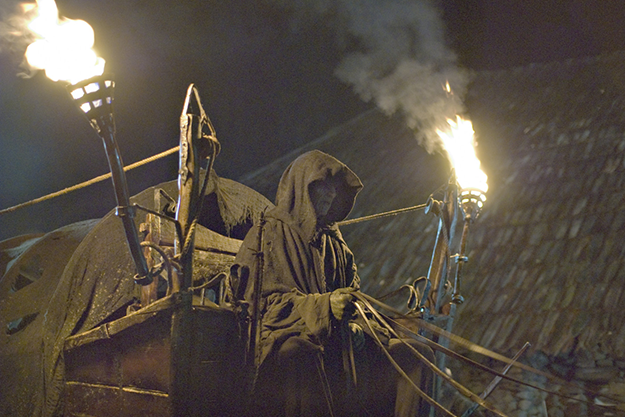
Krabat
Where do you feel like that messed-up timeline comes from? Is it because of funding, because of how things have shifted, or is it more to do with this notion of, “Eh, we’ll fix it in post.”
It’s because we can do it now. In an optical process, you would never have thought of supplying the colorist with mattes to change his color grade. But now you can. So decisions get postponed to the last possible moment. Sometimes it feels like the end product is not valued as much anymore.
The alternative is that you bring the approval process forward, which means you need more time and maybe you spend more money there. There are directors out there who really go for that, who really say, “I want to do it this certain way,” and they push for it more strongly than others. Maybe they have more clout or something like that, and for them, it works.
When a director is very involved, what does that involvement look like? Aside from having good technicians in other departments, or having a good DP.
I think most of it is communication, a willingness to communicate. That’s also why I’m pushing for doing VFX in-house. Because otherwise I feel that we’re just seen as a commodity, not as a part of the team. And for me, it’s important to show the director that I’m actually working on this, and if he or she wants a little piece fixed over here, it may mean a lot of work for me, and since they’re sitting right next to me, they can see how much work it is. At the same time, some things they ask for are super simple to do and I’m not going to charge them a fortune just to profit a company. And I think it’s important that they get interested in the process—[learning] what is possible, what is hard to do. I’m having a really good experience with Ang [Lee] right now. He’s very receptive to that.
The other thing I worked on in New York was Into the Woods. There’s a musical number called “Steps of the Palace,” where Cinderella contemplates if she should go with the prince or go back to her old life. In the film version, Rob Marshall wanted to have that as a frozen time moment, so the idea was she runs down the steps, and then time freezes around her and she starts singing. The steps of the stairs are lit by torchlights that emit little glowy embers, and as she’s singing, all the flames and particles around her are in super slow motion. The production worked with an external effects house in Montreal, and these guys are really good, but once you’re not in the editing room and especially if you don’t see the editor trying out different takes, everything turns into this giant turnaround loop. You spend a certain amount of time working on the shot, and then a lot of time just organizing [it] and getting feedback, and this can be a long feedback loop. And the editor—Wyatt Smith, he’s an ex-flame guy and has a good idea of what can be done—he said, “I know it would be better to bring in somebody in-house to work out the creative issues on the sequence.” So this is how I ended up on that project. Originally I was supposed to only do two or three weeks of temping it—making high quality composites for editorial—but since I was working on the same compositing software that the external VFX house used to final their effects, I was then able to give them my comp setups and say, “This is my setup for this and if you stick to that…”
…it’ll work.
This is 80-85 percent of the way there, so you just make it look good. And Rob was thrilled. They kept us on for four or five months in the end because they really liked what my partner and I were doing on that, so that’s a positive aspect. But again, we were lucky to have a company like Disney in the background that was willing to put up with our added cost.
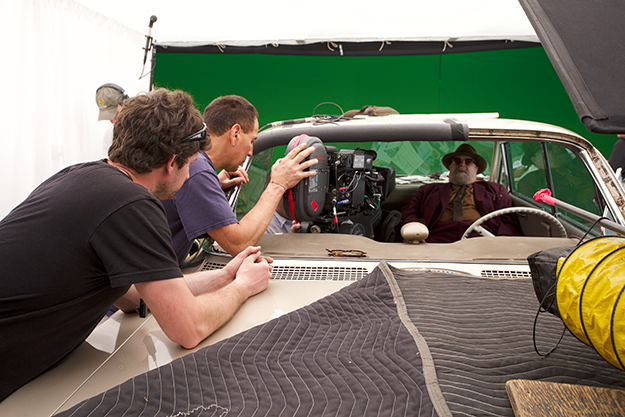
On the set of Inside Llewyn Davis
Certain directors have been known to compose for an iPhone. Is that ever a consideration when you’re working on effects?
No, I know what you’re saying, but I try to ignore that as much as possible. When I was doing commercials, back in the days on the Flame, they used to have those class A monitors from Sony, calibrated to broadcast standard. But they also had a cheap consumer television in the same suite. So when you had your client with you, because any commercial session is very client-driven, you could see how it was going to look on Joe or Jane Average’s TV set at home. And the differences can be remarkable, especially the colors. So yes, I’ve done that before, but for me right now the master is the DCP, what used to be film back in the day.
What makes you know that it looks “right,” that it’s done and you can move on?
What’s right is not an easy question to answer. On set nowadays, you have this tendency of people rushing to the live video play where they can look at a take. Back in the day, people were shooting it, and then they had to wait a day or two to see if it would work or not. And it was the same with effects back then. When you did a title sequence, for example a title fading in and out, you would run your animation camera, fade it off, rewind the camera the precise number of frames your fade-off was, and start again with the exact same fade-up. And so on for every single title. At the same time, you had to keep track of, “Okay, if I mess up one frame of this, I have to go back and start it all over again.” And I think that I try to be very economical and precise because of that.
These days, a lot of companies have fast machines and a fully automated pipeline and whatnot, so you just throw the stuff on there and don’t even think about it. Just press a button and that’s it. But did you really check the whole image? Does it look pleasant to you? I think that’s lost a bit. That’s probably what I mean with things being so industrialized right now, that people don’t feel like it’s their shot. It’s the ownership factor. It’s not your shot because you’re dealing with notes from an internal supervisor who dealt with notes from another internal supervisor, who dealt with notes from an external supervisor, who dealt with notes from the external director, who dealt with notes from the external studio. So it’s a rippling down effect. No wonder this stuff is so expensive.
But the beauty of it is that every job is something new. And I’m really lucky if I work with people who know what they are doing. On Inside Llewyn Davis, again, Bruno Delbonnel was an amazing DP, and [it was wonderful] just talking to him and seeing all that stuff. The colorist on that film, Peter Doyle, he used to be my mentor back in the ’90s. He graded all the Lord of the Rings films, and also a lot of the Harry Potter films, so he came up with a workflow for the Coen Brothers saying, “Listen, I don’t want to give you just any grade, but let’s scan the whole film right from the beginning and I’m going to grade it for you 80 percent of the way, so you edit the film as it’s probably going to look in the end.” And we are not talking about minor adjustments. And if you look at Bruno’s original footage, you might say, “Ooh, that’s not…” But he talks to Peter and he knows what Peter can do, not as an afterthought, but actually as a decision on set. It might not look that way right now, but wait until you see it once he’s done with it.
Everything, every new show or project is a new adventure. The Ang Lee film is about the Iraq War [and is] set in 2004. I am not a big war or weapons buff, so you have to start reading up about how guns react and how fast bullets fly and what muzzle flashes look like in the desert sun…
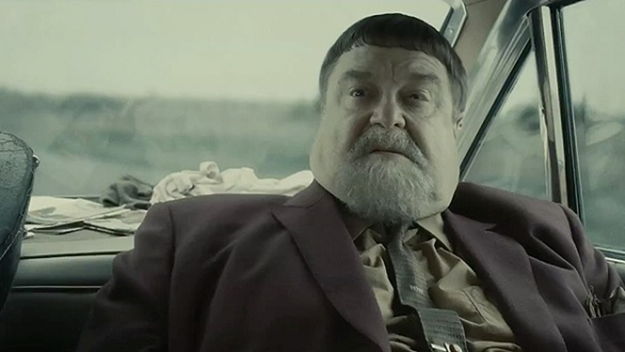
Inside Llewyn Davis
Do you consider yourself an artist?
I always have a hard time referring to people in our industry as “artists” and over the years, I’ve realized that “craftsman,” for me, is probably a much better term. In most cases, I would say 80 percent of the CG artists, as we call them, are craftsmen, and they should embrace that. There’s nothing wrong with being a good, master craftsman. And I would say that a lot of the jobs I am doing are just craft. Sometimes it turns into art when I’m allowed to go out and, let’s say, turn people into ravens. How do you do that? It means coming up with an idea and working with other artists and saying, “What can we do?” This is a process, and it’s not you alone who does that and says, “This is my thing.”
When filmmaking was in its infancy, everybody was in a union, because the labor movement was new and in the public discourse. Nowadays, unions are considered a nuisance, and basically anybody who works with a computer is not unionized. I think that discrepancy is unfortunate, especially considering literally every other department is unionized.
I have been in talks about starting a union, but it is really hard to generate any interest here on the East Coast. The West Coast is much more established; they have the Animation Guild and so on. And it’s the same excuses all the time. “If we’re unionized, we won’t be able to get any jobs.” “Unions never work out.” Health care alone should be a reason for most to start a union! The younger kids, they don’t understand that. I mean, I get that they want to get rid of their student loans as fast as possible, they don’t want to create big trouble as it is, but we really need to look at the big picture here.
Yeah, and I also think people just want to work too. They’re hungry, they want to be as marketable as possible, so they’re thinking, “Well, I am coming out of school with no experience, so I’ll work for less than I really should get paid even though that makes it work for everyone but myself in the long run.”
So it’s really interesting to see that there is a movement to unionize in London. At MPC [Moving Picture Company, part of the Technicolor Group], their compositing department is trying to unionize, which is a big thing. There was an article in Variety last year where the head of MPC was quoted as saying, “Our artists are our most valuable asset,” which led to a stream of commenters, like 600 people saying, “Are you fucking kidding? You make us work these crazy hours for no money and then you have the chutzpah to go out and say that we are your most valuable assets?” So it’s good that people in London are standing up to it, because over here, nothing has really happened.
What are your deadlines like, or what are the expectations for turning this stuff around? Is it reasonable, is it unreasonable, or is it reasonable but your life is kind of ruined while you’re working on it?
Well, it’s gotten better. And being my own boss, I control my own destiny. If I’m working late, it’s because I know I’m the head of my own company, and that’s a different approach than when you’re employed by somebody and told to push buttons or follow orders. When we did Creed last year, we tried to avoid overtime as much as possible. Maybe a day on the weekend towards the end of the show, all paid of course. But not the 100-hour-a-week nonsense that I was doing in the past.



